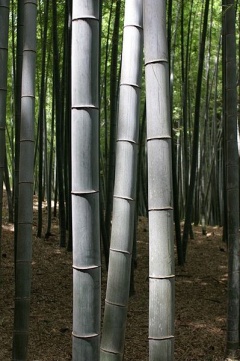Bamboo Canes
| Infobox on Bamboo Canes | |
|---|---|
| Example of Bamboo Canes |  |
| Facts | |
| Origin | Asia |
| Stowage factor (in m3/t) | 8,77 m3/t (bundles) |
| Humidity / moisture | - |
| Ventilation | - |
| Risk factors | See text |
Bamboo Canes
Description
Bamboo is a group of perennial evergreens in the true grass family Poaceae, subfamily Bambusoideae, tribe Bambuseae. Giant bamboos are the largest members of the grass family. In bamboo, the internodal regions of the stem are hollow and the vascular bundles in the cross section are scattered throughout the stem instead of in a cylindrical arrangement. The dicotyledonous woody xylem is also absent. The absence of secondary growth wood causes the stems of monocots, even of palms and large bamboos, to be columnar rather than tapering.
Bamboos are some of the fastest growing plants in the world, due to a unique rhizome-dependent system.
Unlike trees, individual bamboo stems, or culms, emerge from the ground at their full diameter and grow to their full height in a single growing season of 3–4 months. During these several months, each new shoot grows vertically into a culm with no branching out until the majority of the mature height is reached. Then the branches extend from the nodes and leafing out occurs. In the next year, the pulpy wall of each culm slowly hardens. During the third year, the culm hardens further. The shoot is now considered a fully mature culm. Over the next 2–5 years (depending on species), fungus and mold begin to form on the outside of the culm, which eventually penetrate and overcome the culm. Around 5 – 8 years later (species and climate dependent), the fungal and mold growth cause the culm to collapse and decay. This brief life means culms are ready for harvest and suitable for use in construction within about 3 – 7 years. Individual bamboo culms do not get any taller or larger in diameter in subsequent years than they do in their first year, and they do not replace any growth that is lost from pruning or natural breakage. Bamboos have a wide range of hardiness depending on species and locale. Small or young specimens of an individual species will produce small culms initially. As the clump and its rhizome system matures, taller and larger culms will be produced each year until the plant approaches its particular species limits of height and diameter.
Many tropical bamboo species will die at or near freezing temperatures, while some of the hardier or so-called temperate bamboos can survive temperatures as low as −29°C (−20°F). Some of the hardiest bamboo species can be grown in places as cold as USDA Plant Hardiness Zones 5–6, although they typically will defoliate and may even lose all above-ground growth; yet the rhizomes will survive and send up shoots again the next spring. In milder climates, such as USDA Zone 8 and above, some hardy bamboo may remain fully leafed out year around.
Application
Bamboos are of notable economic and cultural significance in South Asia, South East Asia and East Asia, being used for building materials, as a food source, and as a versatile raw product.
Shipment / Storage / Risk factors
Many varieties of cane of a natural yellow colour. Usually shipped in bundles.
Should be of natural colour and free of insect infestation, which may result from prolonged storage. Canes of a grayish colour should be withheld from export. Bamboo canes are liable to split if overstowed with heavy cargo.











